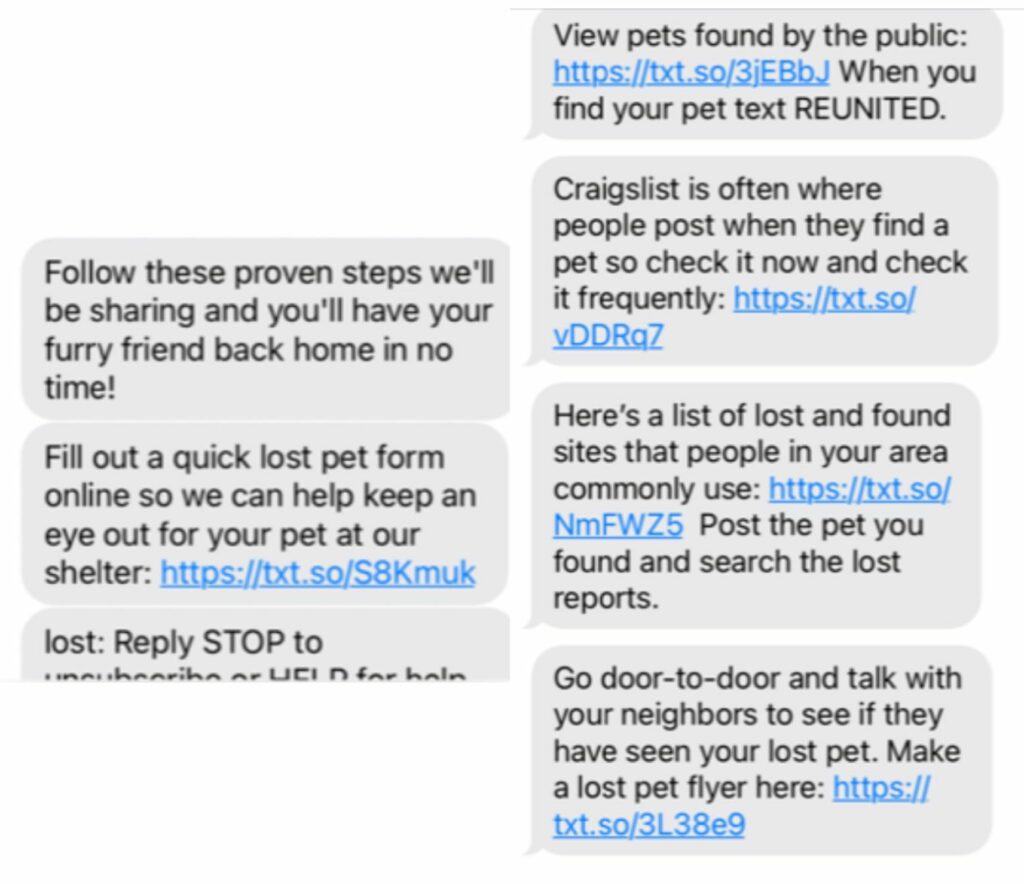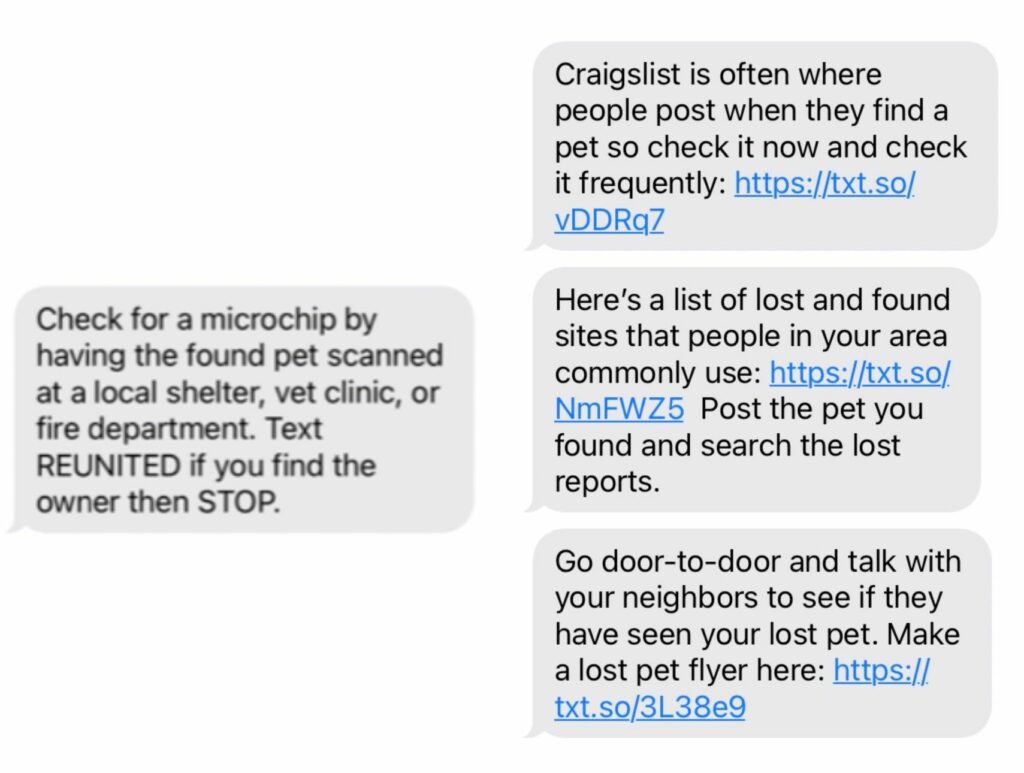About a year and a half ago, Greenville County Animal Care in South Carolina set up a lost and found pets texting program. People who’ve lost a pet text the word LOST to 864-467-3950, and receive an instant reply with information about how to file a lost pet report, and other steps to help locate the missing pet.
Those who’ve found a pet text the word FOUND to the same number. “We’ll text you all of the information and tips you need to help you reunite the cat or dog you found with its lost owner!” GCAC wrote in a Facebook post.
Simple, right? And effective! Shelly Simmons, director of Greenville County Animal Care, tells HASS that before instituting the texting program, the shelter’s return to owner rate was about 15% for dogs. Since putting the texting program in place, that rate has essentially doubled.
“We’re now averaging about 28% to 30% for dogs,” she says.
The rate for cats started low, and has remained low. Shelly says that’s largely because the shelter doesn’t get a lot of cats coming in thanks to community cat programs. But if your organization does have any creative, effective ways to help reunite lost cats with their owners, please reach out and tell us about it!
In fact, the texting program was so successful that at the beginning of last year’s kitten season, GCAC set up another autoresponder for kittens. Text KITTENS to 864-467-3950, and autoresponders will take you through a series of yes and no questions—Did you find a kitten?; Does the kitten have a mom?; Is the kitten sick?; and so on—and based on the responses, eventually the autoresponder will say whether the kitten should come into the shelter or stay where they are with their mom.
“And we incorporate fostering,” Shelly says. “If you want to help foster with these kittens, here’s the link or here’s the phone number to call or text to speak to the foster department. So that’s been pretty cool.”
So cool that six months after that, GCAC text-enabled most of its department lines: their foster department; adoptions; a line for spays, neuters, and wellness, and another just for heartworm treatment. The texts are automatic, but are monitored by shelter employees, who keep an eye out for any that require a human response or action.
What it adds up to: “If you just look at the last 30 days, we’ve had over 3,000 autoresponders that we’ve sent out,” Shelly says. “That’s all information that we would’ve had to do over the phone.”
Shelly generously offered to walk us through how this all works, with tips for other organizations that want to start up lost and found texting programs of their own!
How do you set up a texting program?
Greenville County Animal Care uses a platform called SimpleTexting. Shelly recommends it as “simple” to use. Under current pricing, SimpleTexting offers a plan that allows for 500 outgoing texts per month for $29 per month. One thousand outgoing texts are $49 per month. Nonprofit organizations receive a 15% discount.
GCAC has a yearly plan. “It costs us about a little over $3,000 for the year, and it gives us 90,000 text messages that we can send or receive,” Shelly says. “And then it text-enables five additional lines. So for us, that is well worth it.”
This document has more information about SimpleTexting and other texting services.
You will craft the automated responses. Here’s what GCAC’s look like.
Texting LOST, you immediately get this response about how to file a lost pet report, followed quickly by the next one, with tips on how to search for your lost pet:


Here’s the first autoresponse, when you text FOUND:


These quickly follow, with steps that can be taken right away to help a lost pet be reunited with their family without ever having to enter the shelter:


You can find other sample text autoresponses in this document.
What are the advantages of a texting program?
The texting program offers the ability to help more people more quickly, with instant answers and assistance, any time of day—and in so doing, helps prevent pets from being unnecessarily brought into the shelter.
“We have had positive feedback from customers because they don’t like waiting,” Shelly says. “They don’t like waiting for a phone call back.”
By automating so much communication, the texting program is also helping the shelter cope with understaffing; a problem that is all too relatable. “For the last year and a half, we’ve been down about 25% to 30% of our staff. And so that’s been really a lifesaver for us to be able to still communicate with the community and get their questions answered,” Shelly says.
How do you get the word out?
Greenville puts out a lot of clear, easy-to-understand information about its lost and found texting program in the usual places, like social media and the shelter website. They also put up billboards, and have run paid social media and a paid radio campaign. Shelly ballparks that GCAC has spent about $25k on these promotions, so far.
“We’ve been doing that for about a year and a half,” Shelly says. “That’s been really helpful for us.”
What tips do you have for shelters that want to start a lost and found texting program of their own?
It’s important to do regular checks of your autoresponders, to make sure they are up-to-date and that the embedded links are all still working.
Shelly also advises making sure that staff members are monitoring the texts that are coming in—your texting platform will give you that function—in case they do need a response.
Finally, Shelly recommends just jumping and doing it. “I just think it has done so much more for our community than we can on our own without it because of being able to provide people with multiple ways to communicate with us, and how important that is,” she says. “I think it’s amazing.”
And being generous with her time, plus enthusiastic about this program, she’s offered to serve as a sounding board and resource for any other organization that has questions about starting a lost and found texting program of their own.
Reach out at misimmons@greenvillecounty.org. Yes, the old-fashioned way.
“I have not text-enabled my own number, but that’s a great idea,” Shelly says.
Source: Human Animal Support Services












